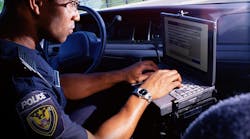The technology embedded in the modern, traffic infrastructure is changing the way police handle running code while responding to calls. By implementing mobile connectivity in units such as V2X antennas, officers can get to scenes faster and in a safer way.
Constant situational awareness, through surrounding connectivity, and preemptive intelligence defines V2X technology. V2X technology allows for traffic control for safer and more efficient driving for all vehicles on the roadway. V2X works when a vehicle is equipped with the technology which connects and responds to other vehicles with the same radio transmitting technology as well as traffic lights or other traffic control devices. The majority of the time, V2X comes in the form of an antenna.The antenna is embedded with the ability to connect to other mobile signals around it.
Danlaw has teamed up with Code 3 to design smart technology to integrate into a vehicle’s system so that it can connect with other mobile connectivity devices implemented on surrounding roadways through their Code 3’s Matrix system. The Matrix is able to program lights and sirens on police units according to customized needs. The software developed in the Matrix allows police fleet operators to customize both the sirens and lights for each fleet vehicle. This means that with a few clicks the officer themselves can choose what sirens and light bar patterns they use for particular situations.
The data collected by the signal is displayed on a monitor inside the dashboard. This includes notifications about weather related road conditions and traffic situations. It will also count down to when a light will change as the vehicle approaches an intersection. Another way it alerts drivers is by vibrating the seat allowing for notification without the need to take eyes off the road. Michael Culton, Content Specialist for Code 3, says that this is especially helpful when a vehicle is approaching a traffic light. “The Matrix acts as the hub for vehicle systems automation,” says Culton. With this integration, the technology in the system is enhanced.
The technology allows the V2X antenna to integrate with Danlaw’s AutoLink Onboard Unit. This uses the emergency vehicle system by Code 3 which allows first responders the capability to have a 360-degree awareness of the vehicles around them. Once emergency lights and sirens are activated on the vehicle, the V2X will communicate and connect with other roadside equipment allowing for preemptive capabilties to be in place. This feature is particularly advanced and will stop cross traffic so that the police vehicle can go through the intersection safely. Such preemptive information may be able to decrease vehicles running red lights and causing accidents.
Culton says operationally the primary objective of V2X technology and the Matrix system is to minimize the number of manual controls in the officer’s vehicle.
“Officers shouldn’t have to worry about manipulating their lights and sirens while running code or making a stop,” he says.
Certain vehicle manufacturers are already designing cars embedded with this technology and it’s been said that within five years this will become even more common. The Federal Motor Vehicle Safety Standard, FMVSS 150, delineates regulations for vehicle manufacturers to adhere to regarding mobile connectivity designed within a car. The list of regulations includes information about the benefits and requirements of V2X technology including safety and cybersecurity. Most of the data collected by the V2X is not stored but used to simply provide warnings and safety alerts to drivers.
Ford has implemented this technology as well. Recently, they announced the deployment of cellular vehicle-to-everything technology (C-V2X) in all of their new vehicle models in the United States that will be launched in 2022. Wesley Sherwood, spokesperson for Ford Motor Company, says this will help make our streets safer and less congested as vehicles will be able to talk to similarly equipped vehicles, pedestrians, cyclists, and traffic lights. “We like to say that current radar and other sensing technologies on vehicles today are like your eyes and C-V2X is similar to your hearing where you can detect things you may not necessarily be able to see,” says Sherwood. It is for this reason that C-V2X will play a key role in further developing self-driving technology through data about the city’s infrastructure as a whole. “For instance, the technology could help identify an emergency vehicle and whether an AV needs to pull over or change route,” says Sherwood.
The C-V2X is a result of multiple technologies working together and connecting various elements of traffic infrastructure. Sherwood says one example is at intersections mobility and wearable devices may be used to show how a pedestrian can communicate intent to cross through Bluetooth and C-V2X. The pedestrian will receive a message from the driver that it is safe to cross. This type of technology may also be used between vehicles in regard to right of way.
Advantage for law enforcement
The biggest advantage for police officers is the preemptive intelligence that is engineered into the system. The ability to obtain alerts such as traffic and road condition warnings, allows officers to not only respond to calls in a more efficient way but it provides added safety when an officer makes a traffic stop. Coulton says vehicles equipped with this type of technology will be sent an alert when they are approaching a police car that has pulled over another vehicle. This way the driver will be aware that they need to slow down due to activity on the side of the road. This factor keeps officers safe and visible when conducting a traffic stop. Preemptive information decreases the chance of police encountering obstacles on the roadways. By being aware of the road conditions ahead, officers can avoid traffic conjestion, road blocks, and other potential obstacles.
Cradlepoint
For law enforcement in particular, Cradlepoint has developed several devices that allow police units to remain connected with their surroundings. The COR IBR1700 is an in vehicle device with five Gigbit Etherrnet ports, precision GPS capabilities, and reliable Wi-Fi. Additionally, the COR IBR900 also has active GPS, two Gigabit Ethernet ports and WiFi as well. The company also has similar items that are designed to be used inside police stations to assist with fleet management. Jonathan Fischer, VP of Business Development for the company says the software is easy for departments to set up and agencies may set up the cloud based system themselves. The software is adaptable to the size of the departments meaning any police agency, no matter how big or small, may utilize this type of technology within their fleet. There are now several grants designed with the purchase of this technology in mind that departments can take advantage of.
Estee Woods, Director of Public Sector and Public Safety Marketing for the company said recently, grants totalling $1.7 billion in available funds are specifically meant for preparedness and could be used for this technology. Departments can look into these types of grants through websites that offer public safety entities funding opportunities such as the United States Department of Justice site.
Cradlepoint’s devices are also Criminal Justice Information Services (CJIS) compliant and provide additional solutions to fleet management including multiple firewalls, bringing those in public safety a greater level of security throughout their daily mission.
The future of the roadway
As technology continues to advance, the V2X capabilities will also increase. This will allow cities and departments, as they grow, to fully leverage the power of mobile connectivity. Since the majority of this technology may be adapted to suit the needs of the fleet and the community, it is obtainable and usable for any department and allows the avoidance of potential hazards or obstacles on the road.
Fleets that equip their units with this technology can have peace of mind knowing their police officers are safer on the roadways so that they may arrive to calls in a timely manner, maintaining their mission of keeping their community safe.



![Catlyst 10667519[1] Catlyst 10667519[1]](https://img.officer.com/files/base/cygnus/ofcr/image/2020/08/catlyst_10667519_1_.5f2aba4ace614.png?auto=format,compress&fit=fill&pad=5&fill-color=white&q=45&h=139&height=139&w=250&width=250)